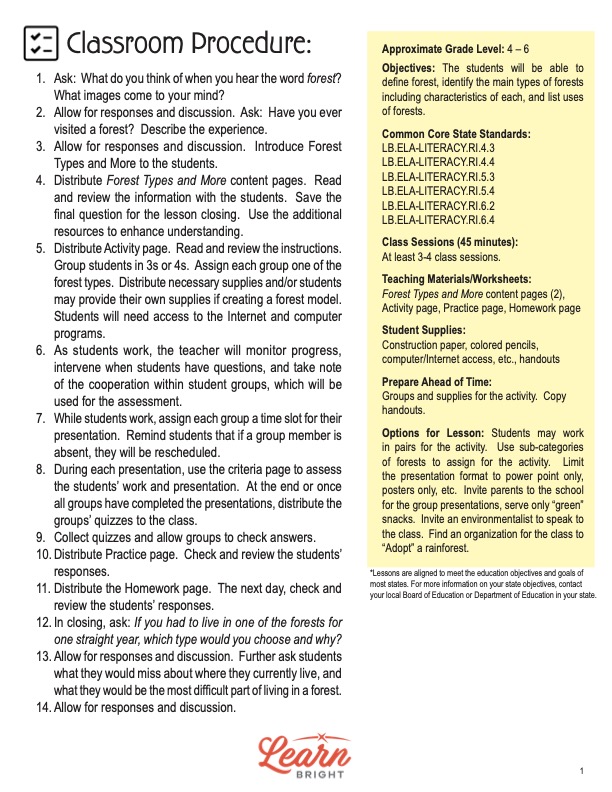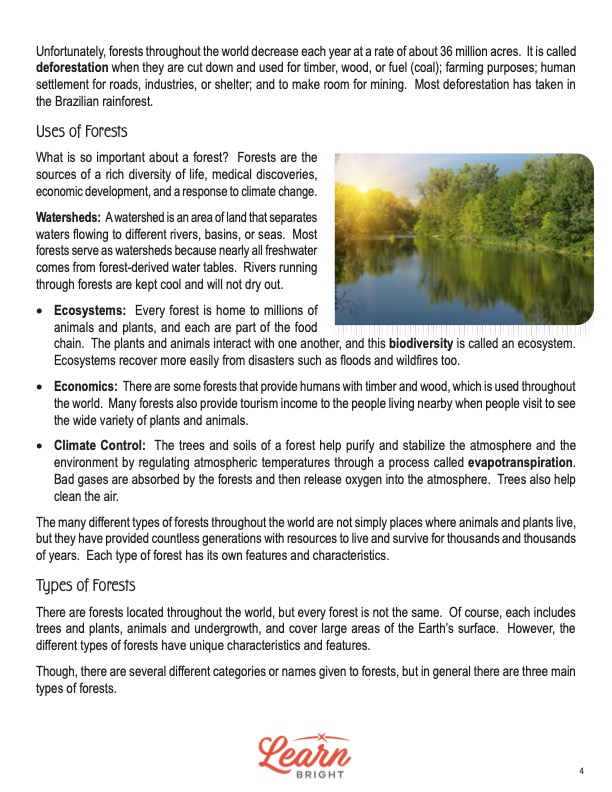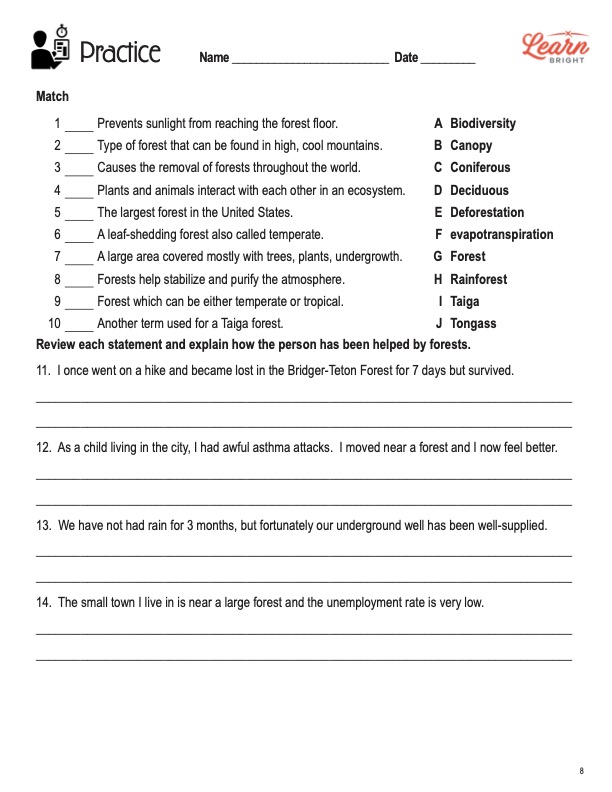Description
What our Forest Types and More lesson plan includes
Lesson Objectives and Overview: Forest Types and More describes the traits of the main types of forests. Students will discover why forests are so useful to people and to other animals and plant life. They will also learn about the largest forests in the world. This lesson is for students in 4th grade, 5th grade, and 6th grade.
Classroom Procedure
Every lesson plan provides you with a classroom procedure page that outlines a step-by-step guide to follow. You do not have to follow the guide exactly. The guide helps you organize the lesson and details when to hand out worksheets. It also lists information in the yellow box that you might find useful. You will find the lesson objectives, state standards, and number of class sessions the lesson should take to complete in this area. In addition, it describes the supplies you will need as well as what and how you need to prepare beforehand.
Options for Lesson
The “Options for Lesson” section of the classroom procedure page lists a few suggestions for additional ideas and activities to incorporate if you want to or have time. For the activity, you could let students work in pairs, and you could assign subcategories of forests to the students. You could also define what type of presentations students can use, such as only posters or only slideshows. Another option is to invite parents to the school to view students’ presentations and serve only “green” snacks. You could invite an environmentalist to come speak to the class and answer questions. One final idea is to find an organization that allows the class to “adopt” a rainforest.
Teacher Notes
The teacher notes page provides an extra paragraph of information to help guide the lesson. It suggests that you teach this lesson in conjunction with others that relate to the environment, ecosystems, habitats, and other related topics. You can use the blank lines to write down any other ideas or thoughts you have about the topic as you prepare.
FOREST TYPES AND MORE LESSON PLAN CONTENT PAGES
What Is a Forest?
The Forest Types and More lesson plan contains three content pages. The lesson first describes how people typically think of trees, plants, and certain animals when they think of forests. Forests can range in size, and they exist throughout the U.S. and the world. Some people use other words to describe them, such as jungle, thicket, timberland, or woods. In fact, people generally refer to wooded areas in their backyards or neighborhoods as woods instead of as a forest.
Students will learn that the United States is home to several large forests, some of which are millions of acres in size. Most of them are west of the Mississippi River. The two largest are both in Alaska. The lesson outlines six of the largest forests in the U.S. in a chart. The largest is in Tongass, Alaska. It covers just under 16.75 million acres of land! The next largest, spanning land in both Nevada and California, covers about 6.25 million acres.
To add perspective, the Tongass Forest is a million acres larger than the state of West Virginia. The 6th largest forest, which is in Montana, is about the size of Connecticut. On a broader scale, water covers about 71% of the Earth’s surface. Forests of all types cover about 31% of the land that remains. The lesson displays a diagram of rectangles that represent water, non-forested land, and forests. Roughly speaking, only 9% of the Earth is forested land.
Deforestation is unfortunately a major issue in the world. This process involves cutting down trees for timber, farming purposes, shelter, and many other things. The collective size of the forests all over the globe decreases by about 36 million acres each year.
Uses of Forests
There is a reason that forests are so important. They are a source of rich diversity of life, medical discoveries, and economic development. They even play a vital role in climate change and control. The second page provides a little information about each of these important uses, starting with forests as watersheds.
A watershed is an area of land that separates water that flows to different rivers, basins, or seas. Most forests serve as watersheds. This is because nearly all fresh water comes from forest-derived water tables. Rivers that run through a forest remain cool and will not dry out.
Forests are ecosystems. Each one is home to millions of animals and plants that are all part of the food chain. The plants and animals interact with one another. This biodiversity creates an ecosystem. Students may find it interesting that ecosystems recover more easily from disasters like floods and wildfires.
When it comes to economics, forests play a key role in several ways. Some forests provide humans with timber and wood, resources that people use all around the world. Many also provide tourism income to the people who live nearby. Visitors can pay a fee to explore the wide variety of plants and animals in a particular forest.
Climate control is one of the most important roles that forests play. The trees and soils help purify and stabilize the atmosphere and environment by regulating atmospheric temperatures. They do this through a process called evapotranspiration. Trees and plants absorb the bad gases and release oxygen back into the atmosphere. They also help clean the air.
Types of Forests: Rainforests
Forests are not simply places where animals and plants live. They have provided generations of people and other living things with resources to live for thousands of years. These habitats are all over, but they are not all the same. They all include trees and other plants and animals, and they cover fairly large areas of land. But each type of forest has unique features and characteristics. In general, there are three types of forests: rainforest, temperate, and taiga.
Rainforests are actually divided into two subtypes: tropical and temperate. (This may be confusing for some students since one of the other major categories of forests is also called temperate. Make sure to help students understand the difference.) These forests are located near the equator. They are very dense and lush with canopies that prevent sunlight from reaching the forest floor. They are also home to about half of the plant and animal species in the world.
The Amazon in South America is the largest rainforest in the world. Rainforests have very high temperatures and lots of rainfall throughout the year. The temperate subtype receives a little less rain than the tropical subtype, and they’re a little cooler. These forests contain four layers: emergent, canopy, understory, and floor.
Types of Forests: Temperate and Taiga
Temperate forests are also known as deciduous forests, meaning that they are home to trees that shed their leaves in the winter. These forests are located in the eastern parts of the United States, Canada, Europe, and Asia. There are four changing seasons in these areas. This type of forest receives the second-most amount of rain. Its summers are fairly mild, but winters can reach below freezing temperatures. A temperate forest consists of five zones: tree stratum, small tree zone, shrub tree zone, herb zone, and ground zone.
Taiga forests are also known as coniferous or boreal forests. They exist only in high and cool mountainous regions, such as North America (Canada), Europe, and Asia. While rainforests are very warm year around, taiga forests have long, cold winters. There is a summer season, but it is short, mild, and wet. Winter days are short while summer days are long, meaning that there is less sunlight throughout the days in winter than in summer. There is also much less wildlife diversity in these forests.
Many people throughout the world live near or in forest habitats. Forests are vital to the environment of the entire planet. They all have special features and traits, and no two forests are exactly the same. They are home to many kinds of animals and plants, which means taking care of them ensures their survival and the survival of future generations of life.
Key Terms
Here is a list of the vocabulary words students will learn in the Forests and More lesson plan:
- Forest—a large area of land that consists mostly of trees, plants, and undergrowth
- Deforestation—the process of cutting down trees for a number of purposes, such as for timber and wood for building supplies
- Watershed—an area of land that separates waters that flow toward different rivers, basins, or seas
- Biodiversity—the various species of plant and animal life within an environment
- Evapotranspiration—the process by which trees help purify and stabilize the atmosphere and environment by regulating temperatures
- Canopy—a layer of rainforest that prevents sunlight from reaching the forest floor
FOREST TYPES AND MORE LESSON PLAN WORKSHEETS
The Forest Types and More lesson plan includes three worksheets: an activity worksheet, a practice worksheet, and a homework assignment. Each one will help students solidify their grasp of the material they learned throughout the lesson. You can refer to the classroom procedure guidelines to know when to hand out each worksheet.
FOREST PRESENTATION ACTIVITY WORKSHEET
Students will work in groups to create a presentation about forests. You will assign each group a specific forest to research. The worksheet lists several types of presentations that students can choose from, such as a short play or skit, 3D model, poster, and so on. Students should include information about the forest’s zones, layers, location, typical weather, the wildlife and plant life that live in it, and other information. Their presentations should be creative, interesting, and include an effective introduction and conclusion. They should be between 10 and 20 minutes long and include a quiz of 10 short questions in any format based on the information they gathered and presented. The second worksheet provides you with a rubric to grade the presentations on and a few lines for comments.
MATCH AND REVIEW PRACTICE WORKSHEET
The practice worksheet is split into two sections. The first section requires students to match descriptions with the correct terms from a word bank. There are a total of 10 descriptions to match. Next, students will review four statements and explain how forests help in each scenario.
FOREST TYPES AND MORE HOMEWORK ASSIGNMENT
Similar to the practice worksheet, the homework assignment is divided into three parts. The first part asks students to explain how five numbers are significant as they relate to the lesson. Next, they will place the layers and zones of two forest types in order from highest to lowest. Finally, they will mark whether each of 10 descriptions relate to a rainforest (A), a temperate forest (B), or a taiga forest (C).
Worksheet Answer Keys
The last two pages of the lesson plan PDF are answer keys for the practice and homework worksheets. The correct answers are in red to make it easier for you to compare them with students’ work. There are a few questions that may contain variation, but students’ responses should reflect the answer keys for the most part. If you choose to administer the lesson pages to your students via PDF, you will need to save a new file that omits these pages. Otherwise, you can simply print out the applicable pages and keep these as reference for yourself when grading assignments.









